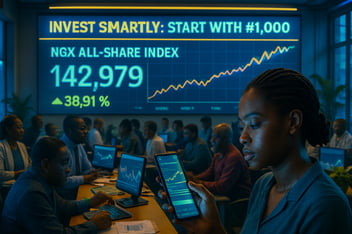
Key Indicators to Know When to Buy or Sell Currencies in 2025
Author Eyitemi Efole
Currency trading presents lucrative opportunities for wealth growth, but navigating the volatile forex market demands well-informed strategies. In 2025, global events, economic shifts, and evolving market psychology continue to drive currency fluctuations. Knowing the right time to buy or sell is crucial for maximizing profits and minimizing risks.
This guide explores essential indicators, blending fundamental and technical analysis with effective risk management. Whether you're a seasoned trader or a beginner, these insights will help you make smarter, data-driven trading decisions in the ever-changing forex market.
Fundamental Analysis: Building a Strong Foundation
1. Economic Growth
A country's economic performance directly impacts its currency value. Monitor these key metrics:
- GDP Growth Rates: High growth typically strengthens a currency, like the U.S. dollar during periods of robust economic expansion.
- Unemployment Rates: Lower unemployment indicates a healthy economy, boosting currency demand.
- Consumer Confidence: Increased consumer spending and confidence signal economic growth.
Stay updated with economic calendars and central bank reports for timely insights.
2. Interest Rates
Interest rates are pivotal to currency valuation. Keep an eye on:
- Monetary Policy Decisions: Central banks, like the Federal Reserve or European Central Bank, adjust rates to control inflation and stimulate growth.
- Interest Rate Differentials: Favorable differentials attract foreign investors, strengthening the currency.
3. Inflation Trends
Stable inflation fosters economic stability. Watch these indicators:
- Consumer Price Index (CPI): Reflects changes in the cost of living.
- Producer Price Index (PPI): Tracks wholesale price trends and signals potential CPI shifts.
4. Government Debt
High debt levels can weaken a currency. Analyze:
- Debt-to-GDP Ratio: A lower ratio indicates fiscal stability.
- Budget Surpluses/Deficits: Surpluses often enhance currency strength.
5. Political Stability
Political and social stability play critical roles in currency valuation. Monitor:
- Elections: Leadership changes can cause short-term volatility.
- Geopolitical Events: Conflicts and trade disputes typically weaken affected currencies.
- Social Unrest: Prolonged instability reduces investor confidence and currency demand.
Technical Analysis: Gaining an Edge with Market Trends
1. Moving Averages (MAs)
Identify trends and reversals with these tools:
- Simple Moving Average (SMA): Smooths price data for a broader view.
- Exponential Moving Average (EMA): Provides quicker signals by prioritizing recent price action.
2. Relative Strength Index (RSI)
RSI highlights overbought or oversold conditions:
- Above 70: Indicates overbought conditions and potential price reversals.
- Below 30: Suggests oversold conditions with upward potential.
3. MACD (Moving Average Convergence Divergence)
MACD helps gauge trend momentum:
- Signal Line Crossovers: Bullish crossovers indicate potential upward trends, while bearish crossovers signal downtrends.
- Histogram: Visualizes shifts in market momentum.
4. Support and Resistance Levels
Recognize critical price points:- Support Levels: Indicate buying pressure, preventing price drops.
- Resistance Levels: Highlight selling pressure, capping price increases.
5. Chart Patterns
Leverage actionable insights from chart patterns:
- Head and Shoulders: Signals potential trend reversals.
- Triangles: Represent continuation or reversal, depending on breakout direction.
Risk Management Strategies: Protecting Your Capital
1. Stop-Loss Orders
Set stop-loss levels to cap losses:
- Example: For a USD/NGN trade at 770, a stop-loss at 760 limits potential downside.
2. Position Sizing
Avoid overexposure by managing trade sizes:
- Risk no more than 2% of your capital on a single trade.
- Use position-sizing calculators for precision.
3. Diversification
Spread risk across multiple currency pairs:
- Pair USD/NGN trades with EUR/USD or GBP/JPY for a balanced portfolio.
4. Stay Updated
The forex market evolves rapidly. Stay informed by monitoring:
- Breaking News
- Economic Data
- Market Analysis Reports
Conclusion
To succeed in forex trading, mastering fundamental and technical analysis is essential. In 2025, the ability to adapt to market changes, combined with disciplined risk management, will be your strongest asset. Always stay informed and invest only what you can afford to lose.
For more tools, insights, and financial product comparisons, visit nairaCompare—your trusted partner in navigating the forex market with confidence.
About Author

Eyitemi Efole
Eyitemi Efole is exploring the marketing field, with a particular interest in brand management, strategy, and operations. She is keen on understanding how brands build trust and connect meaningfully with their audience.
.png?width=1615&height=444&name=nairaCompare%20Christmas%20Full%20Logo%20(White%20%26%20Yellow).png)
.png?width=1615&height=444&name=nairaCompare%20Christmas%20logo%20(PNG).png)








